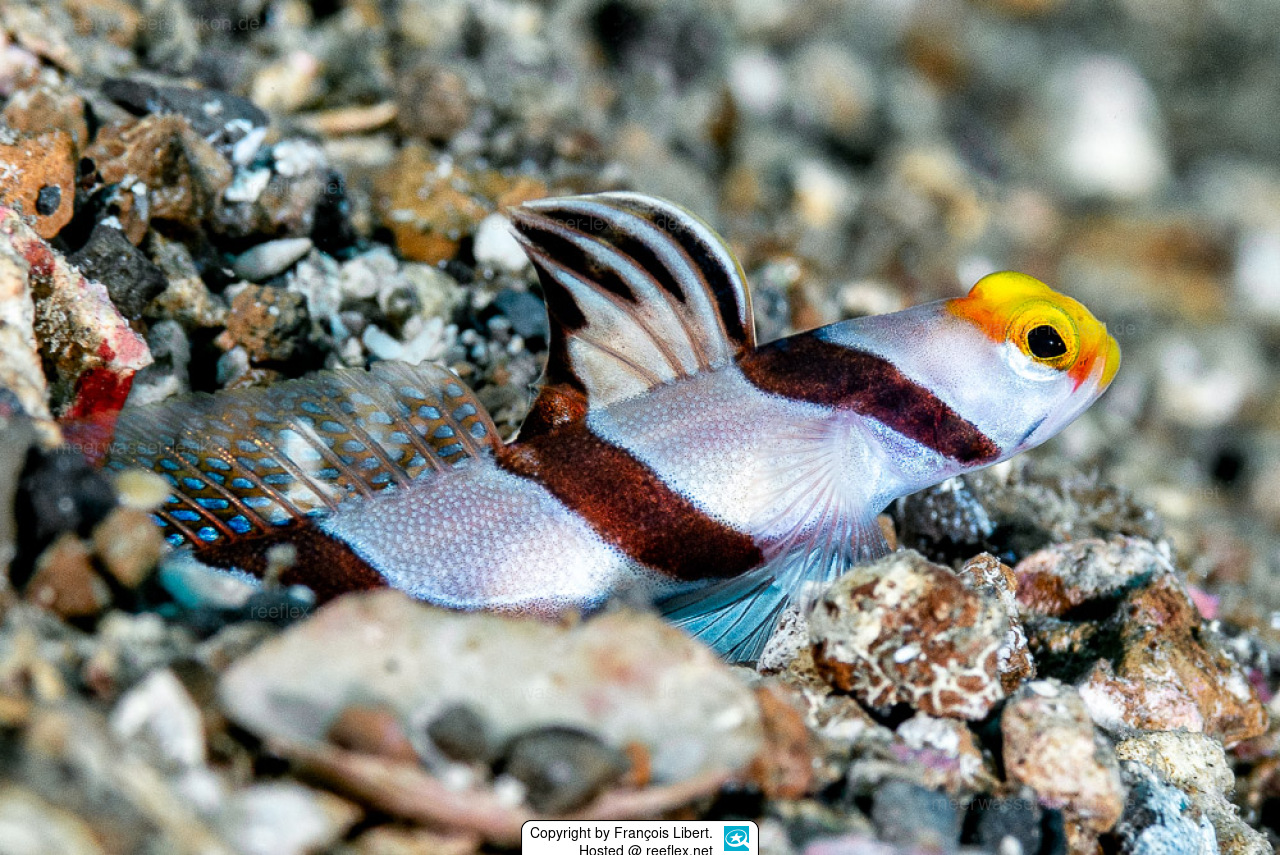Info
Stonogobiops xanthorhinicus, Hoese & Randall, 1982
The Stonogobiops gobies live in symbiosis with the crayfish species Alpheus and are initially very shy and skittish. However, their behavior changes if no too hectic fish are kept in the aquarium.
To acclimatize the goby, it should be accustomed to the available food in a quaternary tank. Feeding should take place several times a day at first and can then be reduced to 2-3 times a day. Good feeding results have been achieved using an acrylic pipette (6 mm) with frozen food by placing the food in front of the cave. The Stonogobiops are not very choosy when selecting food. A prepared cave should be available for transferring the goby to the display tank and a PVC pipe should be placed in the direction of the cave. It is advantageous if the crayfish is the first to move into the cave.
So that the crayfish can build a suitable cave, the substrate should be at least 5-6 cm high in places and also have suitable building material available - coral rubble of at least 2-5 cm.
Jumping guard
A jumping guard prevents (nocturnal) fish from jumping out.
Wrasses, blennies, hawkfishs and gobies jump out of an unprotected tank in fright if their night rest is disturbed, unfortunately these jumpers are found dried up in the morning on carpets, glass edges or later behind the tank.
https://www.korallenriff.de/en/article/1925_5_Jump_Protection_Solutions_for_Fish_in_the_Aquarium__5_Net_Covers.html
A small night light also helps, as it provides the fish with a means of orientation in the dark!
Socialization / symbiosis
The specialist literature states that they live together with Alpheus bellulus. We cannot agree with this statement, Alpheus randalli is the better partner, at least in our experience. When keeping them in an aquarium, pairs should always be preferred. Furthermore, a small aquarium should be available for the shy gobies, in which no larger or hectic fish are present. Not ideal for keeping in a reef aquarium, as the shy goby will not often be seen in front of the cave and will therefore not be able to eat enough food.
There is no known visual difference between the sexes.
The gobies can be kept well together with gentle fish stocking and the keeper will be rewarded by the fact that the gobies can often be seen in front of the cave. Small, calm inhabitants are recommended for stocking - pipefishes, Elacatinus, Eviota, Trimma, Koumansetta, Synchiropus and small shrimp species.
This is not guaranteed for Ecsenius species, damselfish or wrasses of any kind and of course any larger species of fish.
We would be very grateful for any further husbandry experience regarding socialization.
Behavior
If the acclimatized goby has moved into a cave and cannot get out of the cave, this may be due to the tank population or, if kept as a pair, the male is guarding the clutch.
Breeding information:
Stonogobiops are cave breeders and the clutch is guarded by the male.
There are already offspring available for Stonogobiops yasha - see description there.
Danger of confusion
Stonogobiops nematodes looks the same, but has a lance dorsal fin.
They are rarely available in the trade.
Synonym: Stonogobiops xanthorhinica Hoese & Randall, 1982
The Stonogobiops gobies live in symbiosis with the crayfish species Alpheus and are initially very shy and skittish. However, their behavior changes if no too hectic fish are kept in the aquarium.
To acclimatize the goby, it should be accustomed to the available food in a quaternary tank. Feeding should take place several times a day at first and can then be reduced to 2-3 times a day. Good feeding results have been achieved using an acrylic pipette (6 mm) with frozen food by placing the food in front of the cave. The Stonogobiops are not very choosy when selecting food. A prepared cave should be available for transferring the goby to the display tank and a PVC pipe should be placed in the direction of the cave. It is advantageous if the crayfish is the first to move into the cave.
So that the crayfish can build a suitable cave, the substrate should be at least 5-6 cm high in places and also have suitable building material available - coral rubble of at least 2-5 cm.
Jumping guard
A jumping guard prevents (nocturnal) fish from jumping out.
Wrasses, blennies, hawkfishs and gobies jump out of an unprotected tank in fright if their night rest is disturbed, unfortunately these jumpers are found dried up in the morning on carpets, glass edges or later behind the tank.
https://www.korallenriff.de/en/article/1925_5_Jump_Protection_Solutions_for_Fish_in_the_Aquarium__5_Net_Covers.html
A small night light also helps, as it provides the fish with a means of orientation in the dark!
Socialization / symbiosis
The specialist literature states that they live together with Alpheus bellulus. We cannot agree with this statement, Alpheus randalli is the better partner, at least in our experience. When keeping them in an aquarium, pairs should always be preferred. Furthermore, a small aquarium should be available for the shy gobies, in which no larger or hectic fish are present. Not ideal for keeping in a reef aquarium, as the shy goby will not often be seen in front of the cave and will therefore not be able to eat enough food.
There is no known visual difference between the sexes.
The gobies can be kept well together with gentle fish stocking and the keeper will be rewarded by the fact that the gobies can often be seen in front of the cave. Small, calm inhabitants are recommended for stocking - pipefishes, Elacatinus, Eviota, Trimma, Koumansetta, Synchiropus and small shrimp species.
This is not guaranteed for Ecsenius species, damselfish or wrasses of any kind and of course any larger species of fish.
We would be very grateful for any further husbandry experience regarding socialization.
Behavior
If the acclimatized goby has moved into a cave and cannot get out of the cave, this may be due to the tank population or, if kept as a pair, the male is guarding the clutch.
Breeding information:
Stonogobiops are cave breeders and the clutch is guarded by the male.
There are already offspring available for Stonogobiops yasha - see description there.
Danger of confusion
Stonogobiops nematodes looks the same, but has a lance dorsal fin.
They are rarely available in the trade.
Synonym: Stonogobiops xanthorhinica Hoese & Randall, 1982







 François Libert, Frankreich
François Libert, Frankreich













